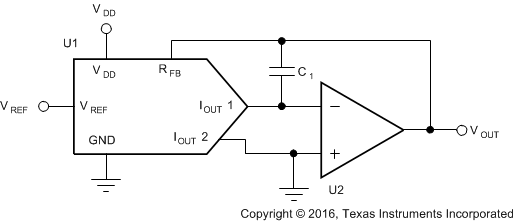SBAS337E April 2005 – March 2018 DAC7811
PRODUCTION DATA.
- 1 Features
- 2 Applications
- 3 Description
- 4 Revision History
- 5 Pin Configuration and Functions
- 6 Specifications
- 7 Detailed Description
- 8 Application and Implementation
- 9 Power Supply Recommendations
- 10Layout
- 11Device and Documentation Support
- 12Mechanical, Packaging, and Orderable Information
Package Options
Mechanical Data (Package|Pins)
- DGS|10
Thermal pad, mechanical data (Package|Pins)
Orderable Information
8.1.3 Stability Circuit
For a current-to-voltage design (see Figure 30), the DAC7811 current output (IOUT) and the connection with the inverting node of the op amp should be as short as possible and according to correct printed circuit board (PCB) layout design practices. For each code change, there is a step function. If the gain bandwidth product (GBP) of the op amp is limited and parasitic capacitance is excessive at the inverting node, then gain peaking is possible. Therefore, for circuit stability, a compensation capacitor C1 (1pF to 5pF typ) can be added to the design, as shown in Figure 30.
 Figure 30. Gain Peaking Prevention Circuit With Compensation Capacitor
Figure 30. Gain Peaking Prevention Circuit With Compensation Capacitor